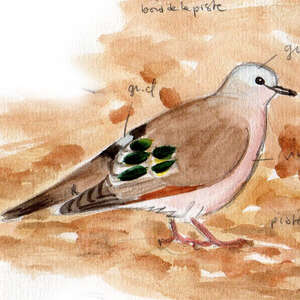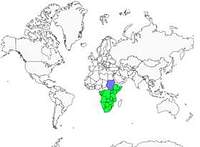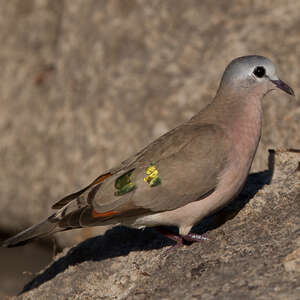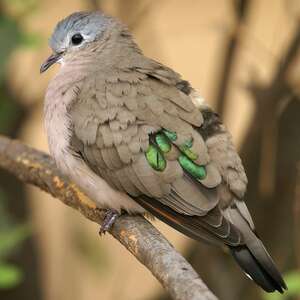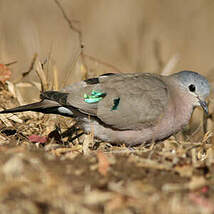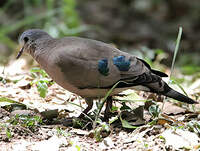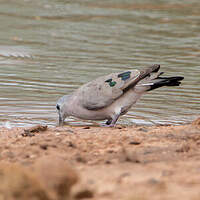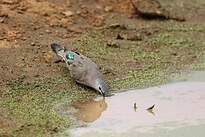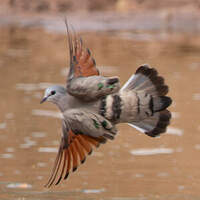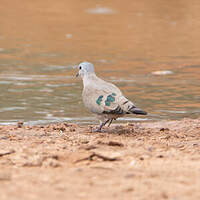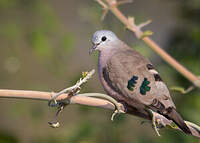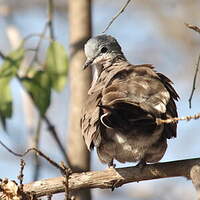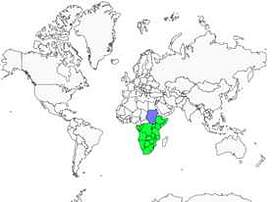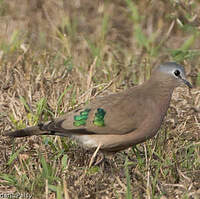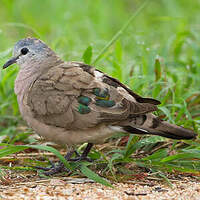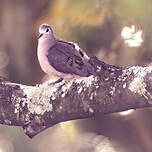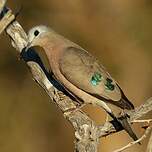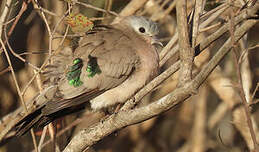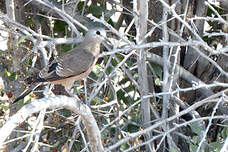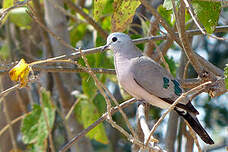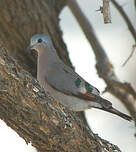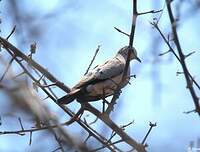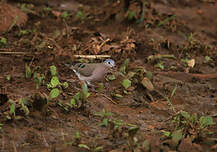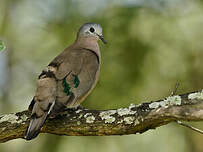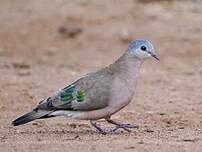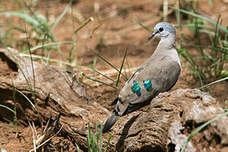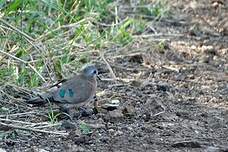Emerald-spotted Wood Dove
Turtur chalcospilos - Tourtelette émeraudine
Identification
The Emerald-spotted Wood Dove was once considered to be the same species as its close relative, the Abyssinian Wood Dove. Their distribution overlapped in some places, but only geographic variations accounted for two subspecies: Turtur chalcospilos volkmanni and Turtur chalcospilos zambesiensis. Nowadays, the two species are clearly separated and each one is monotypic in its own genus. The Emerald-spotted Wood Dove is a small chubby pigeon measuring 20cm. The crown is grey-blue. The forehead, lores and parotids are lightly blue-tinged, giving brightness to its head. The chin, throat, chest and flanks are pinkish-mauve. The belly is slightly lighter-colored. The upper parts are gray-beige. The yellowish-white back has two broad brown stripes. Two other, also brown, stripes can be seen on the tail. The rectrices and primary remiges are brown. The secondary remiges are gray-beige with thin white fringes. Two parallel vertical rows of three or four iridescent spots on some of the large and medium coverts stripe the wing and give the bird its name when, under good light, they appear emerald-green with sometimes gold reflections. The legs are purple-pink. The eyes are brown. The beak is black with a dull red base for populations in the south of the distribution area, entirely black in the north of the area; which had previously accounted for the separation of the species into two subspecies. The underside of the wings is chestnut-colored. With no sexual dimorphism, the female may however be duller than the male. The juvenile is duller and its primary remiges have thin fawn fringes.
Subspecific information monotypic species
Foreign names
- Tourtelette émeraudine,
- Palomita aliverde,
- rola-esmeraldina,
- Bronzeflecktaube,
- bronzfoltos erdeigerle,
- Smaragdvlekduif,
- Tortora boschereccia macchiesmeraldo,
- smaragdfläckduva,
- Grønnflekkalvedue,
- bronzovka lesná,
- hrdlička zelenoskvrnná,
- Smaragdpletdue,
- uikuttajakyyhky,
- Groenvlekduifie,
- tortoreta d'ales maragda,
- turkaweczka zielonoplamkowa,
- Бронзовопятнистая лесная горлица,
- ミドリマダラバト,
- 绿点森鸠,
- smaragdfläckduva,
- 綠點森鳩,
Voice song and call
Habitat
Absent from tropical evergreen forests and semi-desert areas, the Emerald-spotted Wood Dove prefers open forests including secondary forests with a preference for mopanes and acacias.
Behaviour character trait
Non-migratory, the Emerald-spotted Wood Dove lives alone or in pairs. It can however congregate with several individuals near water puddles to drink and at well-known feeding areas of the species.
The only local movements are related to the rainy season. In more arid zones, it will approach cities and take advantage of the urban water supply. It moves on the ground by walking under thick vegetation to look for its food. This is where it spends most of its time. If disturbed, it will fly away with slow wing beats and land on a perch.Flight
Dietfeeding habits
Reproduction nesting
The Emerald-spotted Wood Dove is monogamous. The nesting period varies depending on the area. In the north, reproduction takes place from April to June.
In East Africa, the species is still rather poorly described, although activity peaks in the period from May to June. In southern Africa, it is from January to May and then in September-October. Like many doves, the male courts the female by flying. From a strategic perch, he rises to a vertical height of up to 10 meters, flaps his wings, and descends slowly with wings and tail feathers spread. The nest, fragile, made up of twigs and rootlets forming a platform, is built on tree or shrub branches, usually at 2 meters from the ground and well hidden under the green foliage. It can be used for several years. The clutch is two white-cream eggs. Both sexes incubate for 13-17 days. The young are fed 5 times a day during the same incubation period by both parents. The fledglings are often preyed upon by mongooses and gray shrikes. Once independent, they remain on the parental territory until they reach adulthood.Geographic range
The Emerald-spotted Wood Dove is common and widely distributed in East Africa, from the highlands of Ethiopia to the south-east of South Sudan and the west of Somalia. It is also found in Kenya, Tanzania, the Democratic Republic of the Congo, Zambia and Mozambique, east of South Africa, the north-west of Botswana and along a coastal strip from Namibia to Gabon.
Threats - protection
Sources of information
- IOC World Bird List (v14.2), Gill, F and D Donsker (Eds). 2024-04-18.
- Pigeons and Doves, David Gibbs, Eustace Barnes and John Cox
- Birds of Southern Africa, Tony Roocroft
- BirdLife International, BirdLife International
Other sources of interest
 Specification sheet created on
23/07/2023 by Nathalie Santa Maria
Specification sheet created on
23/07/2023 by Nathalie Santa MariaTranslation by AI Oiseaux.net
© 1996-2025 Oiseaux.net
- Accipitriformes
- Aegotheliformes
- Anseriformes
- Apodiformes
- Apterygiformes
- Bucerotiformes
- Caprimulgiformes
- Cariamiformes
- Casuariiformes
- Charadriiformes
- Ciconiiformes
- Coliiformes
- Columbiformes
- Coraciiformes
- Cuculiformes
- Eurypygiformes
- Falconiformes
- Galliformes
- Gaviiformes
- Gruiformes
- Leptosomiformes
- Mesitornithiformes
- Musophagiformes
- Nyctibiiformes
- Opisthocomiformes
- Otidiformes
- Passeriformes
- Pelecaniformes
- Phaethontiformes
- Phoenicopteriformes
- Piciformes
- Podargiformes
- Podicipediformes
- Procellariiformes
- Psittaciformes
- Pterocliformes
- Rheiformes
- Sphenisciformes
- Steatornithiformes
- Strigiformes
- Struthioniformes
- Suliformes
- Tinamiformes
- Trogoniformes

